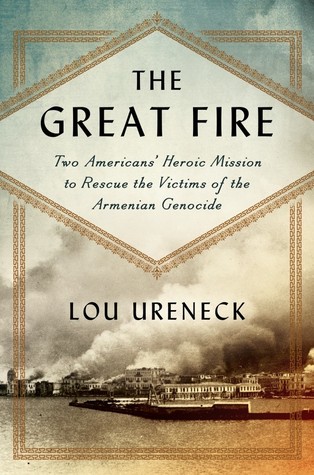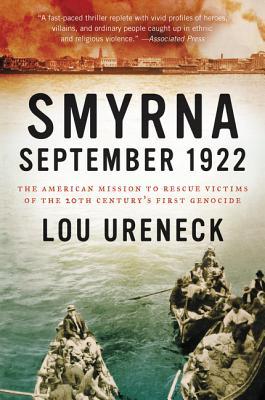First, the setting: Smyrna in 1922 was known to be a very beautiful city. It was ancient. It is mentioned in the bible. It was a major port city for the area. It contained very large tobacco warehouses and was the primary port for exporting tobacco from the Ottoman Empire to the western world. The city was divided ethnically. There were areas in the city for the Greek, Armenian, Turk and Jewish populations, plus a lot of other foreign groups, such as French, Italian, American, British, Russian, etc. It was stated that there were more Greeks in Smyrna than in Athens.
Now, as to our opinions:
Andrea thought that the writing was very good. Lowell was very impressed by the level of research that Ureneck put into the book. Andrea thought that the little personal stories about the various people in the book were well done. I liked the fact that, since this wasn't an 'Armenian' book, Ureneck didn't focus on any particular ethnic group but covered all of them.
Tom thought that the inclusion of the concern about the tobacco processing, marketing, warehouses and shipping was interesting. Azad pointed out that Turkish tobacco was very popular at that time. He also pointed out that, in Syria, tobacco was a government controlled crop. Farmers were hired to grow it, but they didn't own it. We also discussed the fact that in Smyrna during the 1922 disaster several people in power considered that shipping the tobacco in the warehouses was more important than the lives of people.
One thing that I liked was that the author didn't hesitate to include the fact that when the Greek army moved in to occupy the area there were atrocities performed by the Greeks against the Turks, not just by the Turks against the Armenians and Greeks.
Andrea was impressed by the way Jennings worked to bypass Bristol in order to help the refugees. Lowell and Andrea discussed the Norwegian Fridtjof Nanser who helped to save the refugees.
Tom thought that Italy's position in this crisis was so perplexing. It was selling arms and other equipment to the Turkish army.
We discussed the fact that Bristol, acting for the U.S. government, controlled the news stories that were sent back to the U.S., making sure that they stated how fairly the Turks were acting and how the Greeks and Armenians were committing atrocities against the Turks. Fake news 100 years ago. Bristol openly stated that he liked the Turks. He thought that they were a very impressive people, unlike the dark and oily Greeks. Plus, everyone needed to keep on the good side of the Turks in order to continue getting access to the tobacco and the oil.
Both Tom and Azad commented on how this book changed their attitudes about Ataturk. He is normally described as a very fair person, but his actions during this time period showed that he was very brutal in driving the Armenians and Greeks out of Smyrna. His intention was to march any remaining Armenians and Greek in Smyrna into the Anatolian plateau, basically repeating the previous death marches. Today, in Turkey, he is viewed as a hero.
We briefly discussed other books relating to Smyrna. Azad mentioned the book "Smyrna 1922: The Destruction of a City" by Marjorie Housepian Dobkin (an early version was called "The Smyrna Affair"). It has very good reviews. I mentioned the book "Armenian Smyrna/Izmir: The Aegean Community" by Richard Hovannisian. Other books covering this topic include "Paradise Lost: Smyrna, 1922" by Milton Giles, "An Armenian Doctor in Turkey: Garabed Hatcherian: My Smyrna Ordeal of 1922" BY Dora Sakayan, and "Ships of Mercy: The True Story of the Rescue of the Greeks, Smyrna, September 1922" by Christos Papoutsy. This last book was written by the grandson of Asa Jennings, the 'hero' of Smyrna, and is makes use of a lot of his journals and letters.
We discussed many other topics after the book discussion. One interesting topic concerned the recent newspaper story about Minnesota helping house owners to change their deeds to remove clauses which restrict who they can sell their houses to. It turns out that many deeds from 50 or more years ago state that the house can't be sold to blacks, Indians and other unwanted ethnic groups. Tom pointed out that shortly after World War I, some of the deeds specifically mentioned Turks as one of the unwanted groups. He wondered if this is why it took a long time for his grandfather to buy a house. He may have been Armenian, but his passport would have identified him as coming from the Ottoman Empire.
At this point, we had to break up and head home. The next meeting won't be until September. In the next month or so we need to swap emails and decide on what book to read for that meeting.
Until September,
Leroy Erickson
-------------------------------------------------------------------
I agonized over the book club report, finished it up, and sent it off. I then, immediately, realized all of the things that I forgot to put in it. As a way to cover those topics, here is the book review that I had previously posted on the Goodreads web site:
--------------------------------------------------------------------
This was a tough book to read, as the fact that it took almost a month to finish it shows. As I was reading through so many sections of the book I would get very depressed, angry and frustrated in a way that only a non-fiction book can do. This is the story of what happened in the city of Smyrna in 1922.
The setting is that at the close of World War I, the Ottoman Empire had been defeated. The European powers had assigned themselves portions of the empire to administer, to their own benefits of course. Greece had been awarded a portion of Anatolia on the eastern Aegean coast, wrapping around to the northern Mediterranean coast, all of which had been settled by Greeks for 3000 years. Smyrna is right in the middle of that area. The Ottoman Empire had quit fighting, but its army hadn't. One of the military leaders, Mustafa Kemal, who later renamed himself Ataturk, rallied the army, defied the European occupiers and proceeded to take back control of the country. England and France had no interest in any further fighting. The U.S. didn't want to get involved. Italy actually took advantage of the situation to sell arms to the Turkish army. Ataturk led his army against the Greek army defending their territory. No country helped the Greeks at all, so the Turkish army were able to drive the Greeks back until they had to abandon the entire area of Anatolia. At that point the Turkish army and general population continued what they had been doing since 1915. They attacked the Christians in the country, robbing, raping and killing them. The Christians fled to the coasts, with at least 200,000 to 300,000 of them ending up in Smyrna, and with several hundred thousand others scattered across the Mediterranean, Aegean and Black Sea coasts.
Ureneck describes the situation in Smyrna as the Turkish army entered the city. The Turkish army and the general Turkish population attacked the Armenian and Greek sections of the city. Stores were looted. Private homes were broken into. The women were raped and the men were killed. The remaining Greeks and Armenians had no choice but to grab whatever possessions they could and flee to the harbor of Smyrna and try to get on departing ships. Then, the Turkish army started setting fires, which ended up burning through the Armenian and Greek sections of the city and threatening the people at the harbor.
All of that is the depressing part of the story. The frustration comes in when France and England initially refuse to do anything to help the refugees. The anger comes when the highest U.S. official in the country, in Constantinople, refuses to even recognize that there is a problem. He does everything that he can to keep good relations with the Turks, refusing to allow stories that criticize them to be sent back to the states, reporting through official channels that the Turkish army is doing a good job of maintaining peace in Smyrna, and stating that the departing Greek army had performed horrible atrocities against the Turkish people but that the Turks had not responded and were treating the Greeks and Armenians well.
The main focus of the story is on the actions of two people, Asa Jennings, an American minister, and Halsey Powell, a U.S. Navy Lt. Commander. Jennings, on his own initiative, organized safe houses in the city where refugees could stay, get fed and get medical care. Later, he set out on his own to persuade the Greek government to allow several ships to be used to transport refugees from Smyrna and other locations on the Turkish coast to Greece. He worked in conjunction with Powell, who in some cases went directly against his superior's orders to provide American naval support for the safety of the refugees. Through the work of these two people, several hundred thousand lives were saved.
It's angering, frustrating and depressing, but this book is worth reading.
 The ACOM Book Club met on June 20, 2019, at the St. Anthony Park library in St. Paul. In attendance this month were Tom, Lowell, Andrea, Azad and me, a reasonably sized group for June.
The ACOM Book Club met on June 20, 2019, at the St. Anthony Park library in St. Paul. In attendance this month were Tom, Lowell, Andrea, Azad and me, a reasonably sized group for June.